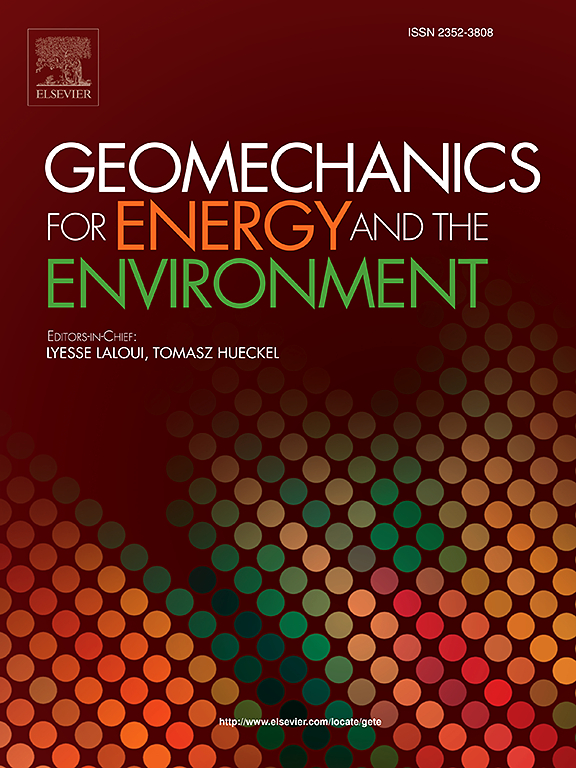多空腔应力释放提高煤层气采收率的数值研究
IF 3.7
2区 工程技术
Q3 ENERGY & FUELS
引用次数: 0
摘要
常规水平井直接压裂技术在深部煤层气地面开采中存在一定的不足。DCBM的开采是制约中国煤层气产业发展的技术障碍。本研究探索了一种涉及多空腔水平井的新方法的潜力,以提高DCBM的提取。基于弹塑性损伤模型和材料点法(MPM),建立了三维数值工具,研究了空腔对煤层气的增渗和解吸作用。通过系统工程仿真验证了DCBM提取的有效性。研究结果表明:1)三维数值工具准确模拟了深部煤层空腔塌陷过程中的大变形、大位移和内边界自接触问题。2)单个空腔对有效应力消除体积的贡献是空腔体积的23.95倍;与初始渗透率相比,塑性区渗透率增加5 ~ 800倍,弹性区渗透率增加1 ~ 5倍,煤层气总解吸量为197.22 m³ 。3)多腔水平井提高DCBM产量是水力压裂的24.98倍,平均产量超过10000 m³ /d,开采1年后仍保持在6000 m³ /d以上。4)通过减小空腔角度和间距,增大空腔宽度和长度,实现多空腔水平井的最佳性能。在此基础上,建议在多空腔水平井中实施复合压裂。该研究为加强DCBM提取提供了数值工具和新的见解。本文章由计算机程序翻译,如有差异,请以英文原文为准。
Numerical study on enhancing coalbed methane recovery using stress relief by multiple cavities
Conventional horizontal well direct fracturing technology is inadequate for deep coalbed methane (DCBM) surface extraction. The extraction of DCBM presents a technical obstacle that impedes the advancement of China's CBM industry. This study explores the potential of a novel approach involving horizontal wells with multi-cavities to enhance DCBM extraction. A three-dimensional numerical tool, based on the elastic-plastic damage model and material point method (MPM), was developed to examine permeability enhancement and CBM desorption induced by cavities. Systematic engineering simulations were conducted to validate the effectiveness of DCBM extraction. The findings are as follows: 1) The three-dimensional numerical tool accurately simulates large deformation, large displacement, and inner boundary self-contact issues during cavity-induced collapse in deep coal. 2) A single cavity contributes an effective stress-relief volume 23.95 times greater than the cavity volume; permeability increases by 5–800 times in the plastic zones and by 1–5 times in the elastic zones over the initial permeability, and a total CBM desorption of 197.22 m³ is achieved. 3) The DCBM production volume enhanced by horizontal wells with multi-cavities is 24.98 times greater than hydraulic fracturing, with an average production exceeding 10,000 m³ /d and remaining above 6000 m³ /d after one year of extraction. 4) Optimal performance of horizontal wells with multi-cavities can be achieved by reducing the cavity angle and spacing while increasing the cavity width and length. Based on these results, implementing compound fracturing in horizontal wells with multi-cavities is recommended. This study provides a numerical tool and new insights for enhancing DCBM extraction.
求助全文
通过发布文献求助,成功后即可免费获取论文全文。
去求助
来源期刊

Geomechanics for Energy and the Environment
Earth and Planetary Sciences-Geotechnical Engineering and Engineering Geology
CiteScore
5.90
自引率
11.80%
发文量
87
期刊介绍:
The aim of the Journal is to publish research results of the highest quality and of lasting importance on the subject of geomechanics, with the focus on applications to geological energy production and storage, and the interaction of soils and rocks with the natural and engineered environment. Special attention is given to concepts and developments of new energy geotechnologies that comprise intrinsic mechanisms protecting the environment against a potential engineering induced damage, hence warranting sustainable usage of energy resources.
The scope of the journal is broad, including fundamental concepts in geomechanics and mechanics of porous media, the experiments and analysis of novel phenomena and applications. Of special interest are issues resulting from coupling of particular physics, chemistry and biology of external forcings, as well as of pore fluid/gas and minerals to the solid mechanics of the medium skeleton and pore fluid mechanics. The multi-scale and inter-scale interactions between the phenomena and the behavior representations are also of particular interest. Contributions to general theoretical approach to these issues, but of potential reference to geomechanics in its context of energy and the environment are also most welcome.
 求助内容:
求助内容: 应助结果提醒方式:
应助结果提醒方式:


